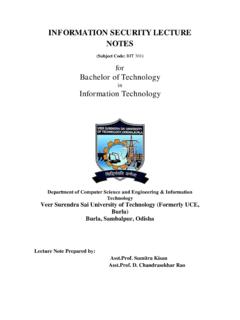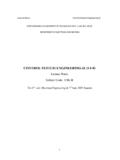Transcription of Lecture Notes on Power Electronics - VSSUT
1 VEER SURENDRA SAI UNIVERSITY OF TECHNOLOGY BURLA, ODISHA, INDIA DEPARTMENT OF ELECTRICAL ENGINEERING Lecture Notes on Power Electronics Subject code BEE1602 6th Semester (Electrical Engineering) Disclaimer This document does not claim any originality and cannot be used as a substitute for prescribed textbooks. The information presented here is merely a collection by the committee members for their respective teaching assignments. Various sources as mentioned at the end of the document as well as freely available material from internet were consulted for preparing this document. The ownership of the information lies with the respective authors or institutions.
2 Further, this document is not intended to be used for commercial purpose and the committee members are not accountable for any issues, legal or otherwise, arising out of use of this document. The committee members make no representations or warranties with respect to the accuracy or completeness of the contents of this document and specifically disclaim any implied warranties of merchantability or fitness for a particular purpose. The committee members shall be liable for any loss of profit or any other commercial damages, including but not limited to special, incidental, consequential, or other damages. (6TH SEMESTER) Power Electronics (3-1-0) MODULE-I (10 HOURS) Thyristors, Static V-I Characteristics of SCR, TRIAC, GTO & IGBT, Turn-On & Turn-OFF Mechanism of SCR, Gate Turnoff Thyristor (GTO).
3 Power BJTs . Power MOSFETs - Insulated Gate Bipolar Transistors (IGBTs) - Basic Structure and VI Characteristics. Static, dynamic and thermal characteristics. Protection, cooling and mounting techniques. Series and Parallel operation of devices. Triggering and basics of driver circuits. Different types of commutation schemes: Natural and Forced commutation. MODULE-II (10 HOURS) 1-Phase Half & Full Wave Controlled Rectifier with various kinds of loads (R, R-L-E (motor)). Midpoint and Bridge type converters. Half Controlled and Fully Controlled Bridge circuits, different waveforms, Input Line Current Harmonics, Power factor, current distortion and displacement factors- Inverter Mode of Operation. Continuous and discontinuous modes, Effect of source inductance assuming constant load current.
4 Effect of freewheeling diode. Three phase bridge converters for different types of load with constant load current, different waveforms. 180 and 120 degree operations. MODULE-III (10 HOURS) DC-DC Converters: Classification of types of choppers, One, Two and Four quadrant operations, Step up and down choppers, Analysis of Type-A chopper, Single-and two quadrant operation with DC motor load. AC-AC Converters: Single-phase mid-point and bridge types of step-up and step-down Cycloconverters. Single phase AC Voltage regulators and its basic analysis. MODULE-IV (10 HOURS) Single-phase Half and Full bridge Inverter, Pulse Width Modulated (PWM) technique for voltage control, SPWM Technique 1-phase inverters, Auxiliary Commutated (Mc-Murray) and Complementary Commutated (Mc-Murray Bedford) Inverters, Three-phase Voltage Source Bridge type of Inverters.
5 (120 and 180 Degree conduction modes), Current Source Inverter. Applications: UPS, SMPS, Induction heating , Electronic Ballast, AC/DC drives speed control. MODULE - 1 Power Electronics The control of electric motor drives requires control of electric Power . Power Electronics have eased the concept of Power control. Power Electronics signifies the word Power Electronics and control or we can say the electronic that deal with Power equipment for Power control. Main Power source Ref signal Power Electronics based on the switching of Power semiconductor devices. With the development of Power semiconductor technology, the Power handling capabilities and switching speed of Power devices have been improved tremendously. Power Semiconductor Devices The first SCR was developed in late 1957.
6 Power semiconductor devices are broadly categorized into 3 types: 1. Power diodes (600V,4500A) 2. Transistors 3. Thyristors (10KV,300A,30MW) Thyristor is a four layer three junction pnpn semiconductor switching device. It has 3 terminals these are anode, cathode and gate. SCRs are solid state device, so they are compact, possess high reliability and have low loss. Control Circuit Digital Circuit Power Electronic circuit Load Feedback Signal SCR is made up of silicon, it act as a rectifier; it has very low resistance in the forward direction and high resistance in the reverse direction. It is a unidirectional device. Static V-I characteristics of a Thyristor The circuit diagram for obtaining static V-I characteristics is as shown Anode and cathode are connected to main source voltage through the load.
7 The gate and cathode are fed from source . A typical SCR V-I characteristic is as shown below: =Forward breakover voltage =Reverse breakover voltage =Gate current =Anode voltage across the thyristor terminal A,K. =Anode current It can be inferred from the static V-I characteristic of SCR. SCR have 3 modes of operation: 1. Reverse blocking mode 2. Forward blocking mode ( off state) 3. Forward conduction mode (on state) 1. Reverse Blocking Mode When cathode of the thyristor is made positive with respect to anode with switch open thyristor is reverse biased. Junctions 1 and 2 are reverse biased where junction 2 is forward biased. The device behaves as if two diodes are connected in series with reverse voltage applied across them. A small leakage current of the order of few mA only flows.
8 As the thyristor is reverse biased and in blocking mode. It is called as acting in reverse blocking mode of operation. Now if the reverse voltage is increased, at a critical breakdown level called reverse breakdown voltage ,an avalanche occurs at 1 and 3 and the reverse current increases rapidly. As a large current associated with and hence more losses to the SCR. This results in Thyristor damage as junction temperature may exceed its maximum temperature rise. 2. Forward Blocking Mode When anode is positive with respect to cathode, with gate circuit open, thyristor is said to be forward biased. Thus junction 1 and 3 are forward biased and 2 is reverse biased. As the forward voltage is increases junction 2 will have an avalanche breakdown at a voltage called forward breakover voltage.
9 When forward voltage is less then thyristor offers high impedance. Thus a thyristor acts as an open switch in forward blocking mode. 3. Forward Conduction Mode Here thyristor conducts current from anode to cathode with a very small voltage drop across it. So a thyristor can be brought from forward blocking mode to forward conducting mode: 1. By exceeding the forward breakover voltage. 2. By applying a gate pulse between gate and cathode. During forward conduction mode of operation thyristor is in on state and behave like a close switch. Voltage drop is of the order of 1 to 2mV. This small voltage drop is due to ohmic drop across the four layers of the device. Different turn ON methods for SCR 1. Forward voltage triggering 2. Gate triggering 3. triggering 4. Light triggering 5.
10 Temperature triggering 1. Forward voltage triggering A forward voltage is applied between anode and cathode with gate circuit open. Junction 1 and 3 is forward biased. Juntion 2 is reverse biased. As the anode to cathode voltage is increased breakdown of the reverse biased junction 2 occurs. This is known as avalanche breakdown and the voltage at which this phenomena occurs is called forward breakover voltage. The conduction of current continues even if the anode cathode voltage reduces below till will not go below . Where is the holding current for the thyristor. 2. Gate triggering This is the simplest, reliable and efficient method of firing the forward biased SCRs. First SCR is forward biased. Then a positive gate voltage is applied between gate and cathode.









